32 Chronic Pain Statistics to Help You Understand Your Health
Written by Karen Selby, RN • Edited By Walter Pacheco
Asbestos.com is the nation’s most trusted mesothelioma resource
The Mesothelioma Center at Asbestos.com has provided patients and their loved ones the most updated and reliable information on mesothelioma and asbestos exposure since 2006.
Our team of Patient Advocates includes a medical doctor, a registered nurse, health services administrators, veterans, VA-accredited Claims Agents, an oncology patient navigator and hospice care expert. Their combined expertise means we help any mesothelioma patient or loved one through every step of their cancer journey.
More than 30 contributors, including mesothelioma doctors, survivors, health care professionals and other experts, have peer-reviewed our website and written unique research-driven articles to ensure you get the highest-quality medical and health information.
About The Mesothelioma Center at Asbestos.com
- Assisting mesothelioma patients and their loved ones since 2006.
- Helps more than 50% of mesothelioma patients diagnosed annually in the U.S.
- A+ rating from the Better Business Bureau.
- 5-star reviewed mesothelioma and support organization.
Testimonials
My family has only the highest compliment for the assistance and support that we received from The Mesothelioma Center. This is a staff of compassionate and knowledgeable individuals who respect what your family is experiencing and who go the extra mile to make an unfortunate diagnosis less stressful. Information and assistance were provided by The Mesothelioma Center at no cost to our family.LashawnMesothelioma patient’s daughter
How to Cite Asbestos.com’s Article
APA
Selby, K. (2023, June 19). 32 Chronic Pain Statistics to Help You Understand Your Health. Asbestos.com. Retrieved April 24, 2024, from https://www.asbestos.com/cancer/chronic-pain-statistics/
MLA
Selby, Karen. "32 Chronic Pain Statistics to Help You Understand Your Health." Asbestos.com, 19 Jun 2023, https://www.asbestos.com/cancer/chronic-pain-statistics/.
Chicago
Selby, Karen. "32 Chronic Pain Statistics to Help You Understand Your Health." Asbestos.com. Last modified June 19, 2023. https://www.asbestos.com/cancer/chronic-pain-statistics/.
Chronic pain is defined as persistent pain lasting at least three months. It has many underlying causes, from arthritis to cancer and more. It affects more than 50 million adults in the U.S. and costs the nation up to $635 billion annually.
Chronic pain prevalence is expected to increase in the coming years due to the aging population, the increase in diabetes and the increase in cancer survival rates. As a result, chronic pain research and management will become increasingly important.
To help patients better understand the state of chronic pain in the U.S., The Mesothelioma Center compiled 32 key statistics on the prevalence, treatment and cost of chronic pain. Explore them below.
Prevalence of Chronic Pain in the U.S.
If you’re not directly impacted by chronic pain, chances are you know someone who is. Advances in medication and treatment make it easy to overlook how many people suffer every day.
- More than 1 in 5 adults in the U.S. experience chronic pain. (source)
- Approximately 8% of adults have high-impact chronic pain. (source)
- Most (84%) of high-impact chronic pain patients are unable to work outside of the home. (source)
- Chronic pain is the No. 1 cause of disability and disease burden globally. (source)
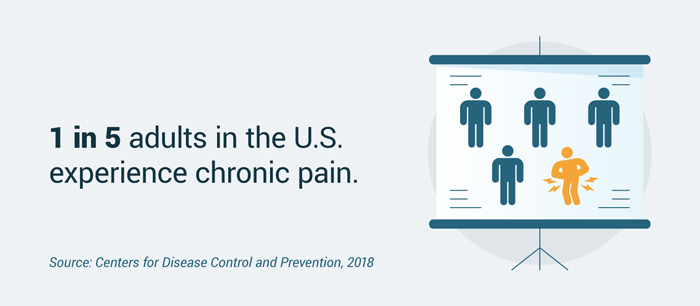
Chronic Pain Demographics
Age, gender, education and income all play a role in who experiences chronic pain.
- Chronic pain is significantly more prevalent in women than men. (source)
- About 65% of adults ages 65 and older experience chronic pain. (source)
- Adults with less than a high school education make up 24% to 28% of all chronic pain patients. (source)
- Adults with public health insurance are more likely to report chronic pain than those with private health insurance. (source)
- Chronic pain is associated with having a total family income of less than $25,000. (source)
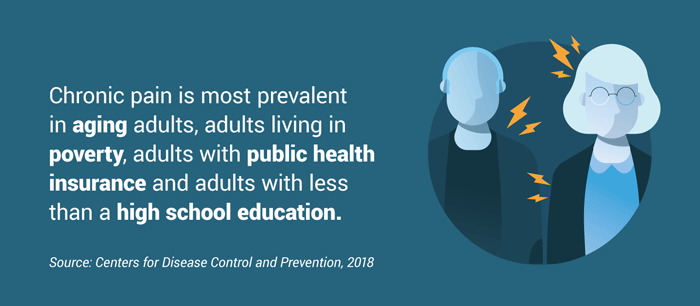
Types of Chronic Pain
Chronic pain tends to fall within four broad categories: Back pain, headaches, neuropathic pain and joint pain.
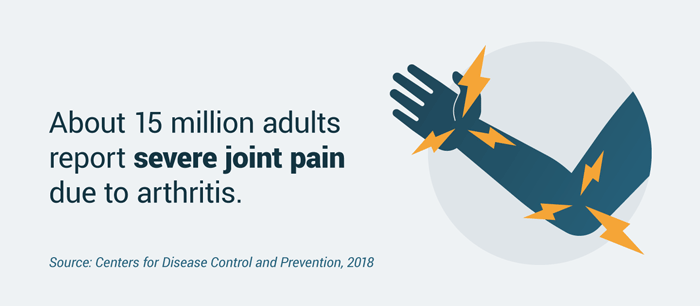
Cancer-Related Chronic Pain
Pain in cancer patients is typically caused by tumors pressing against organs and nerves or when surgeons cut nerves during surgery. Mesothelioma and lung cancer patients often report chest pain because tumors are pressing against the lungs or abdominal cavity. In fact, chronic chest pain is a symptom of respiratory cancers.
- Approximately 75% of cancer patients live with chronic pain. (source)
- Women report greater cancer pain severity than men. (source)
- An estimated 40% of cancer patients experience neuropathic pain. (source)
- Approximately 20% of lung cancer patients experience pain at the time of their diagnosis. (source)
- More than 60% of pleural mesothelioma patients report experiencing pain in the chest. (source)
- Approximately 30% to 50% of peritoneal mesothelioma patients report experiencing pain in the abdomen. (source)
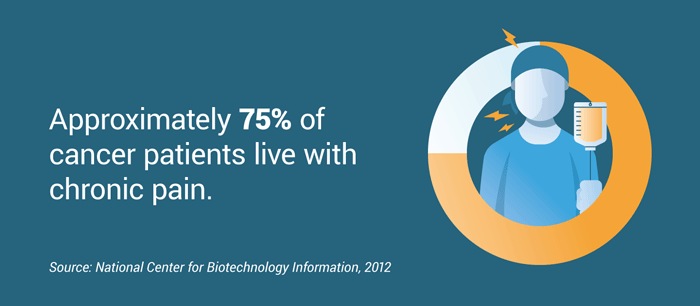
Chronic Pain and Mental Health
Studies have found a link between chronic pain and mental health — specifically, depression, suicide, anxiety and addiction or overdose tendencies.
- People with chronic pain are three times more likely to develop depression and anxiety than those without chronic pain. (source)
- Approximately 21% to 29% of patients misuse opioids prescribed for chronic pain. (source)
- Misuse of prescription opioids causes 17,000 overdose deaths annually. (source)
- People with chronic pain have at least twice the risk of suicide than those without chronic pain. (source)
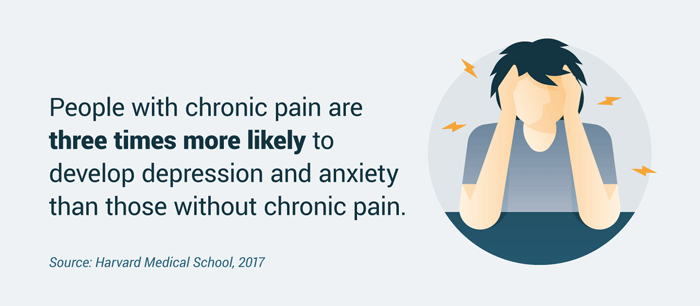
The Cost of Chronic Pain
Costs related to chronic pain are staggering, both on a nationwide and individual level. Total costs outweigh those of the four most prominent
- Chronic pain costs approximately $560 to $635 billion annually in medical expenses, disability programs and lost productivity. (source)
- The total cost of chronic pain is more than that of cancer, diabetes and heart disease. (source)
- Prescription opioids cost an average of more than $800 out of pocket annually. (source)
- Patients with moderate pain pay $4,516 more in annual health care costs than those with no pain. (source)
- Patients with severe pain pay $3,210 more in annual health care costs than those with moderate pain. (source)
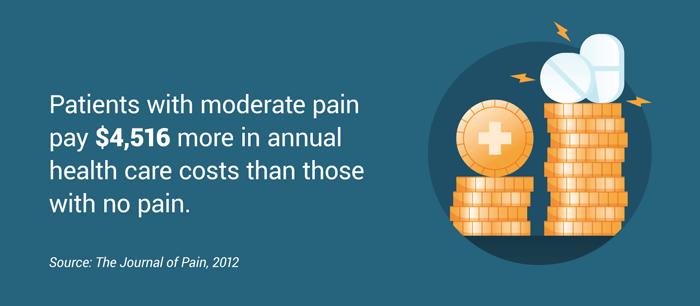
Treating Chronic Pain
For many, prescription medication offers relief from chronic pain. Always consult your doctor before trying any new treatments or medications.
- Prescription medication relieves pain in approximately 58% of people living with chronic pain. (source)
- Approximately 16% to 19% of chronic pain patients receive at least a 90-day supply of prescription opioids. (source)
- About 95% of cancer-related pain can be successfully treated. (source)
- Exercise can reduce pain sensitivity by 60%. (source)
- Only 36% of chronic pain patients report having “good” or “very good” sleep quality. (source)
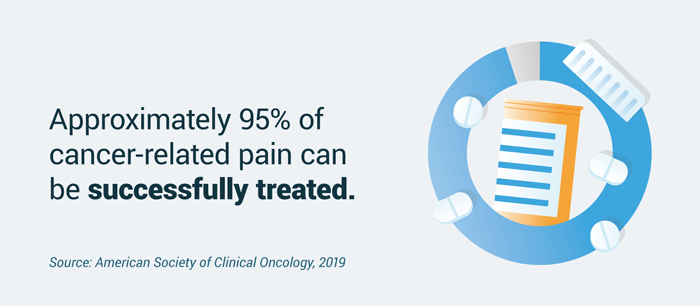
Your doctor may recommend pain treatment based on the cause, location and severity of your pain. The following are common treatments for cancer-related pain:
- Over-the-Counter Medication: Ibuprofen and acetaminophen are commonly taken for mild or moderate pain. They can be obtained without a prescription and the side effects are minimal to none.
- Prescription Medication: Oxycodone, tramadol and morphine may be prescribed for severe pain. Your doctor may combine these with other medications for pain management.
- Surgical Procedures: If you’re a candidate, your doctor may suggest surgery. Neurosurgeons are able to block the nerve pathways that carry pain signals to the brain, helping reduce discomfort.
- Anesthesia: Both regional and local anesthesia in the form of pain blockers or steroids are another option for pain management. They are administered by an anesthesiologist via injection or infusion.
- Palliative Chemotherapy: If chemotherapy is unable to completely cure cancer, palliative chemotherapy may be able to shrink the tumor, resulting in reduced pain and overall improvement of quality of life.
- Rest: Rest, mindfulness and engagement in enjoyable activities may help lessen pain, while fatigue may worsen it. Make sure to get plenty of sleep and pay attention to your pain to better understand and work around it.
Visualizing Chronic Pain
For chronic pain stats at a glance, explore our visual below. Whether you’re a cancer patient, caregiver, chronic pain sufferer or simply trying to learn more about this widespread health concern, take note of these science-based facts and figures.

Throughout your journey with chronic pain, consistent communication with your doctor is key. If you’re experiencing mesothelioma-related pain, mesothelioma symptoms so your medical provider can determine the best treatment. Talk to your doctor about the best medication options, possible side effects and proper dosages. Remember that chronic pain does not define you, and with medical supervision, it doesn’t have to limit you.







